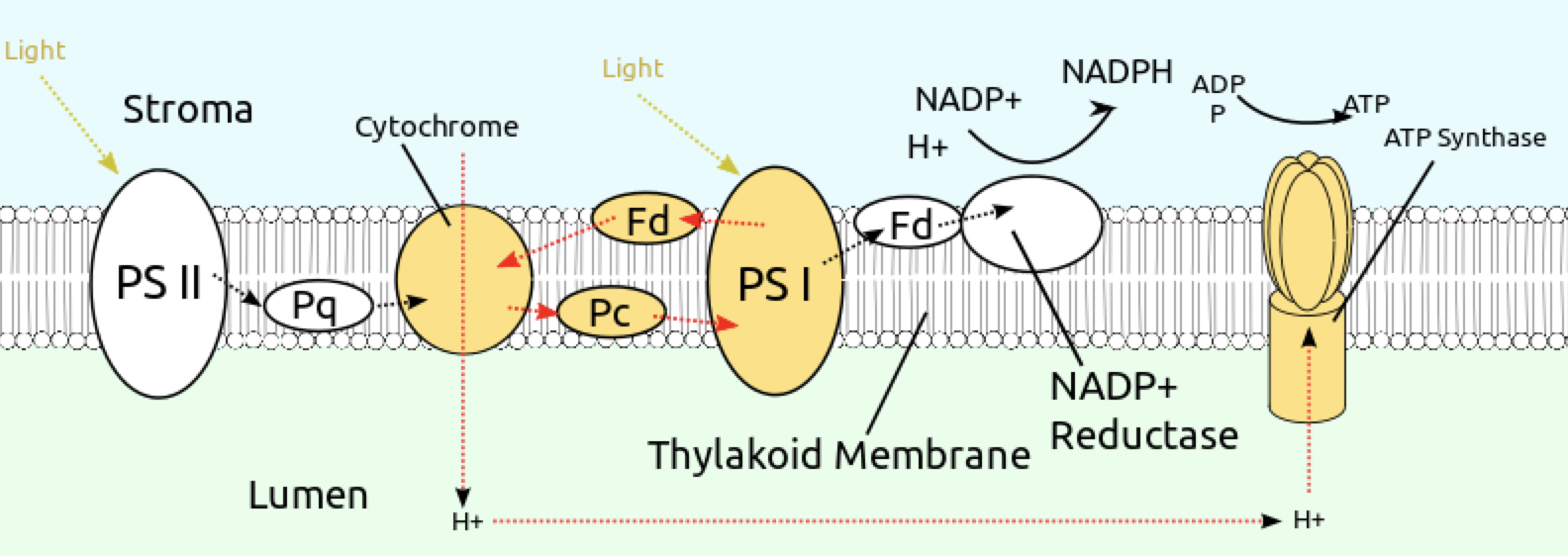
Light reaction in stromal lamellae of the chloroplast results in the formation of
(a) ${ NADPH }_{ 2 }$
(b) ATP + ${ NADPH }_{ 2 }$
(c) ATP
(d) ${ O }_{ 2 }$
Answer
481.2k+ views
Hint:
- Light reaction is a process to produce energy for plants and other photosynthetic organisms. The light reaction that occurs on the stroma lamellae is cyclic photophosphorylation, and the high energy electron released into the chain is returned back cyclically. The products of this reaction are high energy molecules formed due to the electron transfer.
Complete step by step answer:
- Light reactions or photophosphorylation is carried out by photosystem-I or PS-I, located in the stromal lamellae, which carries out both cyclic and non-cyclic photophosphorylation. PS-I is an integral membrane protein complex that uses light energy to catalyze the transfer of electrons across the thylakoid membrane.
- Unlike non-cyclic photophosphorylation, ${ NADP }^{ + }$ does not accept the electrons and they are sent back to the cytochrome ${ b }_{ 6 }f$ complex instead.
- The transport of electrons also generates a chemiosmotic gradient. This occurs from the water-splitting stage that is carried out by PS-II. In this stage, the water molecule is split into oxygen ions, which are liberated in the form of molecular oxygen, and hydrogen ions which are released into the lumen. The high concentration of ions provides energy to form ATP. Given below is the cyclic photophosphorylation.

So, the correct answer is ‘ATP’.
Additional information:
- Non-cyclic photophosphorylation takes place when both PS-I and PS-II are present in the grana membrane.
- The electron acceptors in cyclic photophosphorylation according to their order are PS-I, ferredoxin, cytochrome ${ b }_{ 6 }f$, to plastocyanin, and back to PS-I.
- Photosystem-II or PS-II is located in the grana.
- Cyclic photophosphorylation occurs in aerobic as well as anaerobic conditions.
Note: - PS-I was discovered before PS-II, hence the name. However, experimentally, PS-II occurs first.
- The initial electron acceptors are also strong reducing agents and thus transfer the electrons to more stable carriers.
- The end products of non-cyclic photophosphorylation are $\dfrac { 1 }{ 2 } { O }_{ 2 }$, ATP, and ${ NADPH }_{ 2 }$. ATP is the energy currency of the cell and NADPH is the source of hydrogen atoms needed to drive the Calvin cycle or the dark reaction.
- Light reaction is a process to produce energy for plants and other photosynthetic organisms. The light reaction that occurs on the stroma lamellae is cyclic photophosphorylation, and the high energy electron released into the chain is returned back cyclically. The products of this reaction are high energy molecules formed due to the electron transfer.
Complete step by step answer:
- Light reactions or photophosphorylation is carried out by photosystem-I or PS-I, located in the stromal lamellae, which carries out both cyclic and non-cyclic photophosphorylation. PS-I is an integral membrane protein complex that uses light energy to catalyze the transfer of electrons across the thylakoid membrane.
- Unlike non-cyclic photophosphorylation, ${ NADP }^{ + }$ does not accept the electrons and they are sent back to the cytochrome ${ b }_{ 6 }f$ complex instead.
- The transport of electrons also generates a chemiosmotic gradient. This occurs from the water-splitting stage that is carried out by PS-II. In this stage, the water molecule is split into oxygen ions, which are liberated in the form of molecular oxygen, and hydrogen ions which are released into the lumen. The high concentration of ions provides energy to form ATP. Given below is the cyclic photophosphorylation.

So, the correct answer is ‘ATP’.
Additional information:
- Non-cyclic photophosphorylation takes place when both PS-I and PS-II are present in the grana membrane.
- The electron acceptors in cyclic photophosphorylation according to their order are PS-I, ferredoxin, cytochrome ${ b }_{ 6 }f$, to plastocyanin, and back to PS-I.
- Photosystem-II or PS-II is located in the grana.
- Cyclic photophosphorylation occurs in aerobic as well as anaerobic conditions.
Note: - PS-I was discovered before PS-II, hence the name. However, experimentally, PS-II occurs first.
- The initial electron acceptors are also strong reducing agents and thus transfer the electrons to more stable carriers.
- The end products of non-cyclic photophosphorylation are $\dfrac { 1 }{ 2 } { O }_{ 2 }$, ATP, and ${ NADPH }_{ 2 }$. ATP is the energy currency of the cell and NADPH is the source of hydrogen atoms needed to drive the Calvin cycle or the dark reaction.
Recently Updated Pages
The correct geometry and hybridization for XeF4 are class 11 chemistry CBSE

Water softening by Clarks process uses ACalcium bicarbonate class 11 chemistry CBSE

With reference to graphite and diamond which of the class 11 chemistry CBSE

A certain household has consumed 250 units of energy class 11 physics CBSE

The lightest metal known is A beryllium B lithium C class 11 chemistry CBSE

What is the formula mass of the iodine molecule class 11 chemistry CBSE

Trending doubts
Why was the Vernacular Press Act passed by British class 11 social science CBSE

Arrange Water ethanol and phenol in increasing order class 11 chemistry CBSE

Name the nuclear plant located in Uttar Pradesh class 11 social science CBSE

What steps did the French revolutionaries take to create class 11 social science CBSE

How did silk routes link the world Explain with three class 11 social science CBSE

What are the various challenges faced by political class 11 social science CBSE




